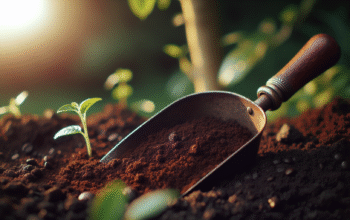?Have you ever watched a coffee plant glow in gentle morning light and wondered how that soft light changes the way it looks, grows, and even how the beans will taste?
Coffee plant in morning light
This article helps you understand how morning light affects coffee plants and what to do when you care for them. You’ll learn about the plant’s biology, best lighting and placement, watering and soil recommendations, pruning and propagation, pest management, harvesting and processing, and tips for photographing your coffee plant in that beautiful early light.

Why morning light matters
Morning light is cooler, less intense, and richer in red and blue wavelengths compared with noon sunlight. This gentle quality helps your coffee plant photosynthesize efficiently without the heat stress that midday sun can cause. You’ll see fresher colors, less leaf scorch, and better overall vigor when the plant receives appropriate morning light.
How light affects coffee plant physiology
Light drives photosynthesis, which converts light energy into the sugars your plant uses to grow and produce cherries. Morning light contributes to opening stomata and initiating daily metabolic routines. You’ll notice stomatal behavior influences transpiration and nutrient uptake, especially during the early hours when humidity is often higher.
Photosynthesis and morning light
In the morning, your plant ramps up photosynthesis, using available light to produce carbohydrates that fuel growth. Cooler temperatures and higher humidity help maintain turgor pressure in cells, which improves CO2 uptake. If you give your plant consistent gentle morning light, you’ll support steady carbohydrate production.
Photoperiod and flowering
Coffee plants respond to day length and light intensity when it’s time to flower. Morning light is part of the daily photoperiod that influences floral initiation. If you manage light exposure and environmental stability, you can encourage healthy flowering and a better cherry set.
Best varieties for indoor and outdoor morning light
Different coffee species and varieties respond differently to light. Arabica is more shade-tolerant and often thrives with softer morning sun, while Robusta likes brighter conditions. Choose a variety based on your light availability and climate so you can maximize the benefits of morning light.
Table: Common coffee types and light preferences
| Variety | Typical light preference | Notes |
|---|---|---|
| Coffea arabica (typica/ bourbon, etc.) | Partial shade to morning sun | Prefers filtered light; morning sun ideal |
| Coffea canephora (Robusta) | Full sun to partial shade | Tolerates higher light and heat |
| Coffea liberica | Partial sun | Tolerant but less commonly grown |
| Hybrids (e.g., Catimor) | Variable; many tolerate brighter light | Choose based on local conditions |
How to position your coffee plant for morning light
Think about where morning sun enters your space. East- or northeast-facing windows are ideal for indoor plants because they receive gentle light that warms leaves without intense heat. Outside, place your plant where it gets direct morning sun and dappled shade for the rest of the day.
Indoor placement tips
Place your plant 2–3 feet from an east-facing window or on a bright windowsill where it receives at least 2–4 hours of direct morning light. If you only have south-facing windows, use sheers or move the plant a little back to reduce afternoon heat. You’ll protect leaves from burning while still giving your coffee plenty of light.
Outdoor placement tips
Outdoors, choose a spot with morning exposure and afternoon shade from trees or structures. If your climate is hot and dry, create a shaded area that filters the harsher midday sun. You’ll encourage healthier leaves and better cherry set with that balance.
Light measurement and monitoring
Use a simple light meter app or handheld lux meter to measure morning light. Coffee plants generally perform well with moderate light levels — around 5,000 to 10,000 lux of morning illumination for many indoor-grown Arabicas. Paying attention to light helps you adjust placement and avoid damage.
Table: Approximate light levels and effects
| Light level (lux) | Effect on coffee plant | Typical situation |
|---|---|---|
| <1,000 lux< />d> | Too low; slow growth | Deep shade indoors |
| 1,000–5,000 lux | Low light; acceptable for shaded varieties | North-facing indoor windows |
| 5,000–10,000 lux | Ideal for many Arabica plants | East-facing morning light |
| 10,000–25,000 lux | Bright light; OK with shade midday | South/southwest morning light filtered |
| >25,000 lux | Risk of leaf scorch | Direct midday sun in hot climates |
Soil, potting, and root health for morning-lit plants
Healthy roots make good above-ground growth possible, especially when the plant receives beneficial morning light. Use well-draining, slightly acidic soil with organic matter to maintain moisture without waterlogging. Proper container choice and potting mix help you control the root environment.
Recommended potting mix
Mix equal parts high-quality potting soil, coarse perlite or pumice, and well-aged compost or coconut coir for water retention. Add a small amount of pine bark or leaf mold to increase acidity. This blend offers drainage, aeration, and nutrient-holding capacity while supporting morning-light-driven growth.
Pot size and repotting
Start with a pot that has good drainage and is only slightly larger than the root ball. You’ll avoid overwatering problems by choosing the right size. Repot every 2–3 years or when roots become pot-bound; repot in spring so morning light and the new environment support recovery.
Watering and humidity for morning-exposed coffee plants
Watering interacts with light — morning light increases transpiration later in the day, so you’ll need to balance moisture. Water when the top inch of soil feels slightly dry; maintain stable humidity around 50–70% for best results. Higher morning humidity reduces shock and supports stomatal function.
Watering schedule guidance
Water deeply but infrequently, allowing excess water to drain. For many indoor plants, watering once a week is common, but adjust based on pot size, temperature, and light intensity. After a bright morning, your plant may dry faster, so check soil moisture rather than sticking strictly to a schedule.
Table: Signs of watering issues
| Symptom | Likely cause | What you should do |
|---|---|---|
| Wilting leaves | Underwatering or root damage | Check soil; water deeply if dry; inspect roots |
| Yellow lower leaves | Overwatering or poor drainage | Reduce watering; repot if roots are rotting |
| Crispy brown leaf edges | Low humidity or irregular watering | Increase humidity; water consistently |
| Dropping leaves after watering | Waterlogged roots | Improve drainage; allow soil to dry slightly |
Fertilizing and nutrition tuned to morning light
Your plant uses spring and morning light to produce growth, so feeding at the right times helps it take advantage of that energy. Use a balanced, slightly acidic fertilizer with a ratio like 10-10-10 or a fertilizer formulated for acid-loving plants. Increase feeding during the active growing season and reduce it during dormancy.
Fertilization schedule
Feed every 4–6 weeks in spring and summer, and reduce to every 8–12 weeks in fall and winter. If your plant receives strong morning light and shows vigorous growth, you can feed at the shorter interval. Always follow label instructions and monitor leaf color as an indicator of nutrient status.
Pruning, shaping, and maintaining a photosynthetically efficient canopy
Pruning improves light penetration and air circulation, which becomes especially effective when morning light reaches lower leaves. You’ll encourage a compact, productive plant by cutting back legginess, removing dead wood, and shaping for even light distribution.
Practical pruning tips
Prune in late winter or after heavy harvests to avoid stressing the plant during its flowering period. Remove crossed branches and thin the canopy to allow morning light to filter deep into the plant. When you prune, make clean cuts just above a node and sanitize tools to limit disease spread.
Flowering and cherry formation under morning light
Coffee blooms are fragrant and often triggered by stable conditions and moisture patterns. Morning light supports the physiology that leads to flower opening, nectar production, and pollinator activity. You’ll see better fruit set when the plant receives consistent gentle morning light and proper care.
Understanding flowering cycles
Flowering often follows a rainy period in outdoor situations; for potted plants, you can simulate consistent conditions by ensuring humidity and water changes that mimic wet-dry cycles. The timing of blooms affects cherry development and ultimately the taste of roasted beans.

Harvesting and processing cherries from plants receiving morning light
When cherries ripen, harvest them by hand to select fully colored fruits. Morning light can make picking easier because cherries are cooler and firmer early in the day. Proper post-harvest processing — washing, fermentation, drying — determines quality and flavor.
Harvesting tips
Pick in the morning when cherries are cool so they don’t ferment prematurely. Selectively harvest ripe cherries to ensure even quality. If you can’t process immediately, store cherries in a cool place briefly to preserve freshness.
Processing basics
There are two main processing methods: washed (wet) and natural (dry). Washed processing typically leads to cleaner cup profiles, while natural processing can accentuate fruity notes. Your morning-handling practices — prompt sorting and controlled drying — influence final taste.
Roasting basics tied to morning harvest routines
After you dry and mill the beans (green beans), you can roast them. Morning routines help you plan roasting to preserve volatile aromatics. Roasting turns green beans into the familiar brown coffee by driving chemical reactions; controlling roast profile affects acidity, body, and aroma.
Simple roasting advice
Start with small test roasts if you’re new. Lighter roasts preserve origin character and acidity, while darker roasts bring body and chocolatey notes. Cool beans quickly after roasting to stop the process and lock in flavors.
Pest and disease management in morning-light conditions
Morning light and humidity can create microclimates that either reduce or increase pest risks. High early humidity reduces water stress but may support fungal issues if air circulation is poor. You’ll stay ahead of problems with regular inspections and appropriate cultural controls.
Common pests and how to act
- Aphids and scale: Inspect undersides of leaves and treat with insecticidal soap or neem oil.
- Spider mites: Increase humidity and use miticides if populations grow.
- Mealybugs: Remove manually and treat with systemic insecticides for severe infestations.
Fungal diseases and prevention
Scale up air circulation and avoid overhead watering that wets foliage. Use fungicides sparingly and focus on cultural prevention: good spacing, pruning for airflow, and avoiding saturated soil.
Propagation and creating more morning-lit plants
You can propagate coffee by seed or cuttings. Seeds need fresh viability and consistent warmth and humidity to germinate, while hardwood cuttings from healthy material root with careful care. Morning light supports young plants by providing gentle energy during the critical early stages.
Propagation by seed
Use fresh seeds, plant them in a moist, well-draining medium, and keep them warm and humid. Provide bright, indirect morning light to encourage steady growth after germination. Expect slow germination that can take several weeks.
Propagation by cuttings
Take semi-hardwood cuttings with several nodes and use rooting hormone. Provide consistent moisture and misting, and place them where morning light warms but does not scorch them. Roots usually form in a few weeks when conditions are right.
Seasonal care adjustments based on morning light
Seasons change the intensity and timing of morning light. In winter, your plant may need supplemental light to maintain growth, while in summer you’ll need to protect it from midday heat. Adjust watering, feeding, and shade accordingly to match seasonal shifts.
Winter strategies
Provide bright, indirect light and reduce watering to avoid root rot. If morning light is weaker, consider adding a full-spectrum grow light on a morning schedule to simulate extended bright hours. You’ll need to reduce fertilizer frequency during lower growth.
Summer strategies
Shift your plant to a place that protects it from intense afternoon sun. Increase humidity and check soil more often since higher temperatures and strong light will accelerate drying. You may also cut back on heavy pruning to avoid encouraging new growth that could be heat-stressed.
Aesthetic and design tips for photographing coffee plants in morning light
If you want to photograph your coffee plant, morning light is forgiving and produces attractive highlights and soft shadows. Place the plant so light grazes the leaves and accentuates texture, and use shallow depth of field to isolate details like dewy leaves or flowering clusters.
Composition and technical tips
Shoot during the golden hour shortly after sunrise when light is warm and directional. Use a reflector to fill shadows if needed and shoot at eye level for a natural perspective. You’ll get compelling photos by focusing on contrast between glossy leaves and matte soil.
Table: Quick care checklist for morning-lit coffee plants
| Task | Frequency | Notes |
|---|---|---|
| Check soil moisture | 2–3 times per week | Water when top 1″ is slightly dry |
| Inspect for pests | Weekly | Look under leaves and at nodes |
| Fertilize | Every 4–6 weeks (growing season) | Use acid-balanced fertilizer |
| Prune light shaping | Annually or as needed | Late winter or after harvest |
| Repot | Every 2–3 years | Spring is best |
| Provide morning light | Daily | 2–4 hours direct morning sun preferred |
Environmental and sustainable practices you can adopt
You can reduce waste and increase sustainability by using composted materials, collecting rainwater for irrigation, and reusing containers. Sustainable processing of cherries and careful use of chemicals will protect local ecosystems while helping you produce better beans.
Small sustainable actions
Use organic compost, avoid unnecessary synthetic chemicals, and save coffee pulp for compost when you process cherries. You’ll enhance soil structure and microbial activity, which improves plant health and reduces long-term input needs.
Troubleshooting common morning-light issues
If your plant shows signs of stress, match symptoms to causes: pale leaves might mean nutrient deficiency; scorched edges suggest too much direct sun; slow growth can mean insufficient light or poor soil. Diagnose by checking light levels, soil, and leaf condition.
Symptom-action guide
- Pale, yellowing leaves: Check pH and nutrients; consider iron or nitrogen supplements.
- Brown leaf tips: Increase humidity and avoid sudden water changes.
- Leaf drop after placement change: Gradually acclimate the plant to new light.
- Moldy soil surface: Improve drainage and reduce surface moisture.
Bringing coffee plants into interior design and rooms with morning light
Coffee plants add texture and a subtle fragrance when they flower, making them excellent indoor companions. Place them near east-facing windows where morning light enhances their green color and creates a calming atmosphere. You’ll get both a living ornament and a small-scale production plant if you care properly.
Design considerations
Pair your coffee plant with other humidity-loving plants like ferns to create a microclimate. Use matching containers with drainage and avoid decorative pots that trap water. You’ll create a cohesive display that keeps the plant healthy and looks intentional.
Final thoughts on morning light and your coffee plant
Morning light is a gentle, powerful ally for your coffee plant. You’ll support photosynthesis, reduce stress, and highlight the plant’s natural beauty by placing it in the right light, providing balanced water and nutrients, and paying attention to seasonal shifts. Whether you keep a single potted plant by your window or manage a small backyard patch, understanding morning light will improve both plant health and the quality of your cherries.
A simple daily routine to maximize morning light benefits
- Check soil moisture and water if needed.
- Rotate the plant slightly to encourage even light exposure.
- Inspect for pests while the plant is cool and the leaves are fresh.
- Note any buds or flowers and support with stable humidity.
You’ll see the payoff in healthier leaves, more regular flowering, and a stronger connection to the plant’s natural rhythms. With consistent care and attention to morning light, your coffee plant will be a thriving, rewarding presence in your home or garden.



